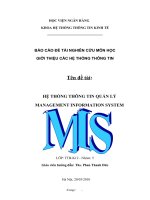Lecture Business management information system - Lecture 25: Business intelligence
Bạn đang xem bản rút gọn của tài liệu. Xem và tải ngay bản đầy đủ của tài liệu tại đây (959.6 KB, 34 trang )
Business
Intelligence
Lecture 25
What is Business Intelligence (BI)
Definitions:
•
Business Intelligence (BI) refers to skills, processes, technologies, applications and
practices used to support decision making.
•
Systems that provide directed background data and reporting tools to support and
improve the decision-making process.
•
A popularized, umbrella term used to describe a set of concepts and methods to
improve business decision making by using fact-based support systems. The term is
sometimes used interchangeably with briefing books and executive information
systems.
•
Business Intelligence is a broad category of applications and technologies for
gathering, storing, analyzing, and providing access to data to help clients make better
business decisions.
•
A system that collects, integrates, analyses and presents business information to
support better business decision making.
•
Business Intelligence is an environment in which business users receive information
that is reliable, secure, consistent, understandable, easily manipulated and
timely...facilitating more informed decision making
What is BI (continued)
Improving organizations by providing
business insights to all employees leading to
better, faster, more relevant decisions
© 2008 Accenture. All Rights Reserved.
What is Business Intelligence?
Business Intelligence enables the
business to make intelligent, fact-based
decisions
Aggregate
Data
Database, Data Mart, Data
Warehouse, ETL Tools,
Integration Tools
Present
Data
Reporting Tools,
Dashboards, Static
Reports, Mobile Reporting,
OLAP Cubes
Enrich
Data
Add Context to Create
Information, Descriptive
Statistics, Benchmarks,
Variance to Plan or LY
Inform a
Decision
Decisions are Fact-based
and Data-driven
CPU – Content, Performance, Usability
Content
Performance
The business determines the “what”, BI enables the “how”
Minimize report creation and collection times (near zero)
Usability
Delivery Method Push vs Pull
Medium Excel, PDF, Dashboard, Cube, Mobile Device
Enhance Digestion “A-ha” is readily apparent, fewer clicks
Tell a Story Trend, Context, Related Metrics, Multiple Views
Core Capabilities of BI
OLAP (online
analytical
processing) enables
a user to easily and
selectively extract
and view data from
different points-ofview.
Why do companies need BI?
What’s the best that can happen?
Competitive Advantage
Optimization
What will happen next?
Predictive Modeling
What if these trends continue?
Forecasting/extrapolation
Tactical /
Strategic BI
Why is this happening?
Statistical analysis
Alerts
What actions are needed?
Query/drill down
Ad hoc reports
Standard reports
Where exactly is the problem?
Operational BI
How many, how often, where?
What happened?
Sophistication of Intelligence
© 2008 Accenture. All Rights Reserved.
How Important is BI?
Top 10 Business and Technology Priorities for 2011:
1. Cloud computing
2. Virtualization
3. Mobile technologies
4. IT Management
5. Business Intelligence
6. Networking, voice and data communications
7. Enterprise applications
8. Collaboration technologies
9. Infrastructure
10. Web 2.0
Source: Gartner’s 2011 CIO Agenda (aka “
The July 2010 Forrester report “Technology
Trends That Retail CIOs Must Tap to Drive
Growth” identified the following technologies
that retail CIOs should be considering as
part of an overall architecture strategy:
Mobile
Social Computing
Cloud
Supply Chain
Micropayments
Business Intelligence/Analytics
Why is Business Intelligence So Important?
Time
Data
Opinion
(aka Best Professional
Judgment)
Making Business
Decisions is a Balance
In the absence of data, business decisions are often made by the HiPPO.
With Business Intelligence, we can get data to you in a timely manner.
Benefits of Business Intelligence
•
Improve Management Processes
–
•
Improve Operational Processes
–
•
planning, controlling, measuring and/or changing resulting in
increased revenues and reduced costs
fraud detection, order processing, purchasing.. resulting in
increased revenues and reduced costs
Predict the Future
Examples
- EMC
•
•
•
•
1998: Revenue $2.5b
1998: HW (90%) + SVCS (10%) + SW (0%)
Strategic BI: predictive modelling => decision
made
HW (10%) + SVCS (10%) + SW (80%)
2010: Revenue $16b
EMC Quarter Activity
Typical Activity by Week ($M) (Storage Products)
• Factories ship ≈40% of quarterly revenue in last
week!
• Build to Stock for orders in last two days!
700
$ Millions
600
500
Factory Shipments
400
300
Bookings
200
100
0
1
2
3
4
5
6
7
8
Fiscal Week
9
10
11
12
13
EMC Order Life Cycle
Suspect
Prospect
Lead
Account Planning
Oppty
Quota
Configure
Price
Quote
Order
Channel Integration
Produce
Ship
Invoice
Collect
Project
Commissions
Accounting
Service
Examples
- Walmart
•
Average daily sales of American Flags = 6,000
•
September 11th 2001
•
All competitors ran out of flags
•
Nearest rival sold 20,000
•
Walmart sold 116,000 flags on that day alone
Further examples
•
Call centres
–
e.g. Top Agent awarded bonus -> competition leading to performance improvements
•
Banks
–
jettison walk in customers to encourage online only
•
Criminal Minds
–
•
Information gathered on previous actions of serial killers allows the team to predict the actions of future serial killers
Revenue Service
–
who has the yacht but cannot afford it
•
Plagiarism detection in colleges
•
Customer Loyalty Programs
•
Twitter analysis for public mood
•
Dell
•
Healthcare
–
predicting infection in rural parts of third world
BI Golden Rules
•
Data Quality & Accuracy
•
Data Consistency
•
Data Timeliness
“Get the right information to the right people at
the right time”
Gartner BI Maturity Model
Major BI Trends
Mobile
Cloud
Social Media
Advanced Analytics
TDWI Executive Summit – August 2010
What BI technologies will be the most
important to your organization in the next 3
years?
Predictive Analytics
2. Visualization/Dashboards
3. Master Data Management
4. The Cloud
5. Analytic Databases
6. Mobile BI
7. Open Source
8. Text Analytics
1.
Advanced Analytics / Predictive Analytics
Data Mining
Regression
Monte Carlo Simulation
“Statistically Significant”
Predicting Customer Behavior
Churn/Attrition
Purchases
Profiling
BI Today vs Tomorrow
“BI today is like reading the newspaper”
BI
reporting tool on top of a data warehouse
that loads nightly and produces historical
reporting
BI tomorrow will focus more on real-time
events and predicting tomorrow’s
headlines
Collegiate Admissions Criteria
Test Scores: SAT, ACT, AP Exams
Grade Point Average
Class Rank
High School “Strength”
Extracurricular Activities: Band/Choir, Clubs, Sports
Non-School Activities: Work, Volunteer, Community Groups
Area of Focus – Intended Major
Family legacy
Home State or Country
Regression Outcome = Graduation (binary) + GPA (linear)
Retail Analytics
Market Basket Analytics
Text Analytics
Customer Segmentation/Clustering
Tailored Product Assortments
Inventory Forecasting
Amazon.com and NetFlix
Collaborative Filtering tries to predict other items a
customer may want to purchase based on what’s in their
shopping cart and the purchasing behaviors of other
customers
25









